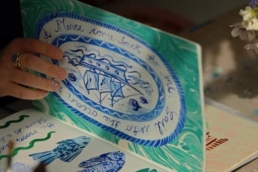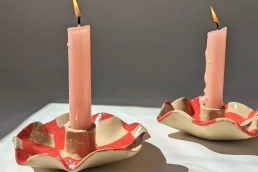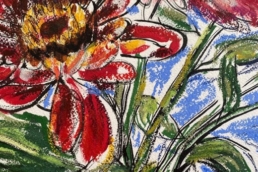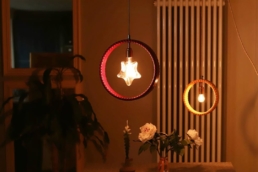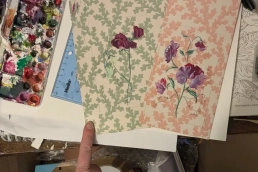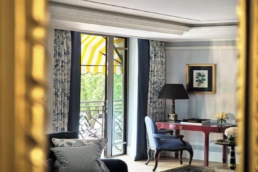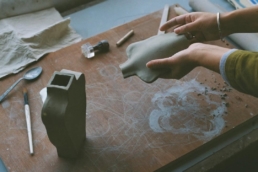From her studio in the Scottish countryside, Fi McDougall creates art that celebrates the poetic beauty of the natural world. As the founder of Wilderframe, Fi crafts original floral sculptures and wall art that blend traditional botanical techniques with a contemporary eye.
Drawing from her background in English literature, and a lifelong fascination with plants and flowers, her work is rooted in both symbolism and structure. Each piece is hand-cut, thoughtfully assembled, and carefully framed using sustainable materials and intricate, hand-finished details that reflect Fi’s mindful approach to making.
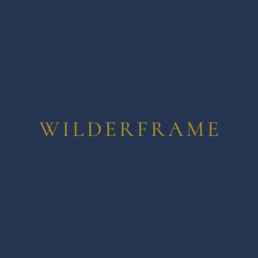
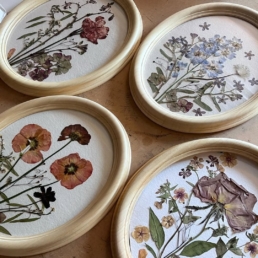
1. Can you tell us a bit about yourself and your artistic journey?
I began my career as an English teacher and had never, until recently, considered the possibility that I might be able to make a living from creating things. I have always, however, had a deep respect for craft and a love of plants and flowers.
It was towards the end of the Covid lockdowns, while on maternity leave, that I started exploring a range of crafts and mediums I’d not touched for years. I was struggling with Post-Natal Depression and felt so relieved to be doing something for me and something that felt productive during the stolen hours when the kids were sleeping.
2. What inspired you to pursue your craft? Was there a defining moment or influence that sparked your passion?
I have a tendency to get a bit obsessive and pressing flowers really captured my imagination. I came back to my childhood hobby through the lens of adult interests in Victorian literature and the practice of keeping herbaria; I sympathised with the desire to identify, collect and freeze an ephemeral moment during an uncertain time. All other techniques I have used subsequently are connected to this impulse.
I have been incredibly lucky to have found people who have supported me through sharing, buying, commissioning or exhibiting my work and enabled my practice to grow organically.
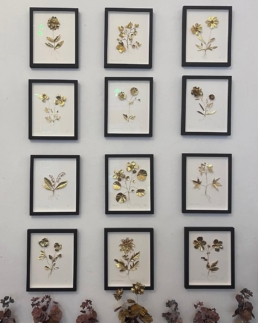
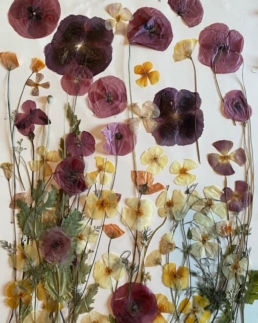
Your craft
3. How would you describe your work in three words?
Floral, decorative and nostalgic
4. What materials or techniques do you use, and why are they important to your process?
I am not very good a sticking to one medium or technique. I’m still experimenting and suspect I will continue doing so forever! The unifying theme is flowers, and I try to work from real life as much as possible. I enjoy using metal because it is so materially different to a flower, but can be used to render one beautifully. It’s a satisfying contrast.
5. Can you tell us about a favourite piece you’ve created and the story behind it?
A large circular pressed flower collage, over a meter in diameter, which charts the flowers in our local area from early Spring to late Summer. It was one of the first pieces I made for an exhibition and it received such generous feedback during the show. I loved watching people examine it, identifying the flowers and often sharing nostalgic recollections of childhood.

Creative process
6. What does a typical day in your studio or workshop look like?
No day is the same! I’m trying to get better at organisation and admin, and I find that ticking off a few tasks first thing can help me to get going. I then often get out about five different projects, make quite a lot of tea, and hit my peak level of productivity just before I have to hit pause!
7. Do you have any unique rituals or habits that help you stay creative?
I am not sure any of my habits are particularly unique, but the things I find most helpful are long walks and conversations with creative friends. And podcasts in the studio that are distracting enough to silence some of the internal chatter but that don’t steal all my attention!
8. How do you handle creative blocks? Do you have any strategies or tips for overcoming them?
I’m still in the very early stages of my creative career and welcome tips from anyone! In my short experience, I have found that if I’m struggling with a particular project, I need to relax and let it sulk in the periphery. Re-inspiration often finds me when I’m happily working on something else!
Challenges and successes
9. What’s the biggest challenge you’ve faced as a maker, and how did you overcome it?
Learning how to managing time. In teaching, my timetable was managed for me and I’m still adjusting. I’m chronically bad at prioritising, estimating how much time things will take and therefore planning my workload effectively. I need the pressure of a deadline but also get wildly anxious. I am a long way from overcoming it, but through seeking out the wisdom of friends, and getting people to hold me to interim deadlines, I’m getting at least a little better.
10. What’s been your proudest moment or achievement so far?
Exhibiting in a group show at Dalkeith Palace with other artists whom I greatly admire. I felt completely fraudulent but it was a real turning point in my fledgling career where I sold well and thought I might try to really give this a go.
11. What’s your favourite quote you’ve ever heard about your work? Who said it, or what was the name of the publication?
‘it must have taken ages’, or ‘it’s so detailed and looks like the real thing’
– Overheard by people coming over to the studio
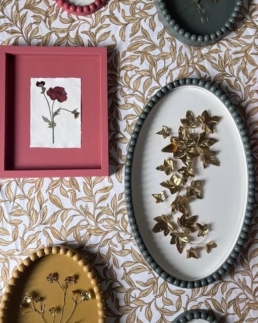
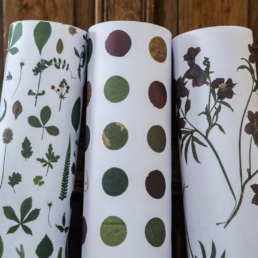
Inspiration
12. Where do you draw inspiration from for your work? What sparks your imagination and creativity?
My inspiration comes from the garden, from literature and from my own research. I also attend regular courses and workshops to continue learning new skills. There is no doubt that looking at beautiful things is one of the most powerful ways of igniting my imagination. But I need to be careful not to get over-stimulated: the access to boundless material on social media can often have the reverse effect and ends up being a bit disheartening or distracting.
13. Do you have a favourite artist, maker, movement, or tradition that has influenced your craft?
I think I’m most interested the social and aesthetic discourse of the Arts and Crafts movement, which seems germane to our own era, although it is not a straightforward relationship.
I’ve also just discovered the work of metal sculptor Shota Suzuki; his work is achingly beautiful!
14. How does colour influence your practice; is it an important part of your process? Do you have a particular palette or favourites? Any go-to sources for colour inspiration?
Colour is very important to my work, often for framing choices but increasingly for the works themselves as I use a wider range of media. Most inspiration comes from the flowers in the garden!
Perspectives and goals
15. What role does your environment play in shaping your creativity?
It is central to everything; the garden provides all my models! I’m also fully submerged in family life which no doubt informs the why and how of everything I do.
16. What do you want people to feel when they experience your work?
I would love people to feel the same joy as when they see a beautiful flower in the wild; I try to use enough accuracy in the rendering of any specimen I create to capture some of the evanescence of nature.
17. What are you currently working on, and what excites you most about it?
I am working on a new collection of potted plants and collages that incorporate a more literary element. I adore the feeling of starting out in a new direction and feel very excited to be combing some of my passions more explicitly. The scale is growing which is both daunting and exciting!
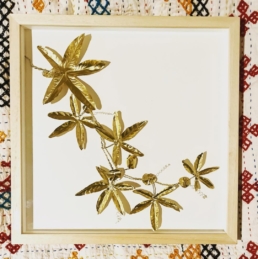
Advice and reflection
18. What advice would you give to someone starting out as a maker?
Build a community to people who can boost you up when you’re struggling with imposter syndrome or a crisis of confidence! I would not have managed without the help of more experienced makers and artists who have been generous with their wisdom and encouragement.
19. If you could go back to the start of your career, what advice would you give your younger self?
Have confidence in your own style. If it doesn’t work straight away, it doesn’t mean it won’t work at all. I’m on a permanent quest for authenticity which is hard to find against the background noise of social media.
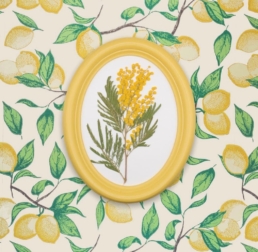
Closing thoughts
20. If you could collaborate with any artist, past or present, who would it be and why?
Mary Delany, the remarkable eighteenth-century artist who created botanical masterpieces in collage. Her work is exquisite and incredibly scientifically accurate and I imagine she would have an infectious and generous creative energy alongside an enviable botanical knowledge. Her artistic endeavours traverse many crafts, but her most prolific period arrived later in life; a source of constant inspiration!
21. Where can people find your work, and how can they support you?
My work is primarily available in small drops on my website, www.wilderframe.co.uk, group exhibitions and via a small number of retailers. The best way to keep up to date with new work is via instagram, @wilderframe!
To explore more of Fi’s work, follow Wilderframe on Instagram and visit the website to discover the latest collections, commissions, and botanical pieces designed to bring nature, and a touch of poetry, into your space.
Explore Wilderframe’s latest collection and follow her creative journey:



